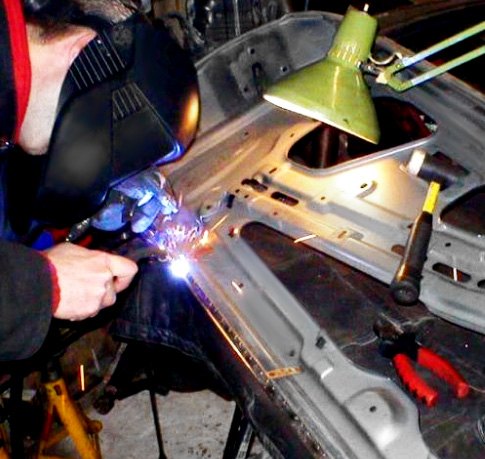"Do I need a door skin or do I need a door shell?" That's one of the most common questions asked when it comes to repairing dented or rusted doors. In this article, we'll clarify exactly what door skins and door shells are, and we'll give you a general idea of what bodywork is required with each in order to help you make a more informed purchase.
All car doors consist of a frame to which trim and window components are mounted, and an outer metal layer that's attached to the outside of the frame. A "door skin" is the outer metal layer only. A "door shell" includes both the outer skin and the door frame, and is shipped preassembled with the skin already welded and bonded to the door frame. Door frames will also include the metal window surround, unless the vehicle uses "frameless windows".
The big decision whether to purchase the less expensive door skin or the more complete door shell rests on the answers to two questions: one, what is the extent of damage on my vehicle? And two, what is the availability for my particular year, make, and model ride? Let's take each of these in turn.


Door Skins
A door skin must be lightly hammered onto the door shell, crimped around the edges of the frame until the metal is flat, then secured in place permanently using either adhesives, welding, or brazing. "Brazing" is a metal-joining process where a filler metal is heated to its melting point, then distributed between two or more close-fitting parts to create a seal.
When a door shell is manufactured on an automaker's assembly line or an aftermarket supplier's factory, the joining process is typically performed by robots that spot weld with pinpoint accuracy, and it's difficult to match those levels of perfection by hand.
Body shop professionals are experienced when it comes to replacing door skins, but many in the business believe that an imperfect seal here will allow moisture, water, and contaminants to enter the door and cause corrosion. Until recently, replacing a sheet metal door skin required plug welding it to the door frame in dozens of spots. Advances in modern adhesives created for this purpose now allow door skins to be literally glued on, and body shops are increasingly using this process themselves.

Manufacturers of sheet metal adhesive have performed tests where two panels were glued together, then pulled apart. When sufficient pressure was applied, the metal tore before the glue failed. Because these bonding adhesives are available to the public, assembling your own door shell is easier than ever to do at home. Sheet metal adhesive is not a replacement for welding on all areas of the vehicle, but for door skins it can be perfectly satisfactory.
Simply put, damage which is confined to the skin may allow you to get away with replacing just the skin. Is it collision damage or rust-out which is being fixed? Collision damage oftentimes extends into the door frame itself, so be careful about hidden damage! You may think the dent is only in the skin. But it's during the disassembly that you discover how deeply the damage extends. Corrosion, on the other hand, will sometimes be confined to only the skin.
Door skins are a great value if you feel up to the task of doing this type of work yourself, because you'll avoid any labor charges, which can quickly add up. If you won't be doing the work of joining the skin to the door frame, it's essential to find a trustworthy body shop that can. Be sure what you save buying just a door skin isn't lost in labor. Remember the old skin has to be removed, the rest of the door made useable, and the new skin installed.
Insurance companies typically cover only replacement skins if they can get away with it, so expect that if you're dealing with a claim. They save money that way because of pre-negotiated labor rates with specific body shops they use, and skins are most effective for them.

Door Shells
Door shells usually require less labor compared to skins. If the amount of time you have to work on a repair project is limited, or you're looking to get your car finished as soon as possible, door shells arrive ready to paint right out of the box with minimal (if any) corrective bodywork necessary.
What’s Available For My Car Or Truck?
Regarding the question "what's available for my car or truck?" the answer often is "it depends". For example, if you are purchasing for a 2000 Ford F-150, then we’ve got complete door shells from the Replace brand. Note that "left" and "right" indicate "driver's side" and "passenger side" respectively.
If the vehicle in question is a 1981 Pontiac Firebird, the Auto Metal Direct brand can supply left and right door skins. Since we don't see door shells for our Firebird, the body shop needs to salvage the existing shell, or possibly seek a good used part if the existing one cannot be re-used.
What about a 1973 Dodge Challenger? The Goodmark brand provides the option of either a door skin or complete door shell. Note the price differences! Again, if your repair allows you to pick either, remember that labor amounts may differ significantly.
Door Skins
For other vehicles, we’ve got Autometal Direct Door Skins for classic and 1999-2006 Chevy pickups, vintage muscle cars from GM and Chrysler, and G-body Oldsmobile Cutlass Supreme / Buick Regal Grand National models through 1988. Goodmark Door Skins focus on vintage GM, Ford, and Chrysler muscle cars – including GM G-body coupes through 1988.
Sherman Door Skins cover 1967-72 GM pickups, OER Outer Door Skins focus on 1967 Camaro/Firebird and other select GM muscle cars, and Replace Door Skins are available for select GM, Ford, and Dodge pickups from 1988-2008.
Door Shells
When it comes to door shells, Replace Door Shells cover a wide range of makes and models from today back through the late ‘60s. Auto Metal Direct Door Shells cover Chevy cars back to 1947, select vintage GM and Chrysler muscle cars, and full-size pickups/Blazers/Suburbans through 1991. Goodmark Door Shells also cover those same vehicles, with the addition of vintage Mustangs and GM mid-size G-bodies through 1988.
Sherman Door Shells offer good coverage for 1964-68 Ford Mustangs, vintage GM muscle cars, and pickups from GM, Dodge, and Toyota from the 1970s through 2010. OER Door Shells specialize in 1967-81 Chevy Camaros, and Omix-ADA Full Doors are available for Jeep Cherokee and Wrangler models dating back to the 1980s.

Whatever car or truck you drive, being educated about these choices available will make you a more informed shopper who is able to make the most appropriate selection for your needs. Should you have any questions while searching through our products, we welcome your calls seven days a week!

